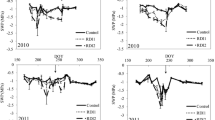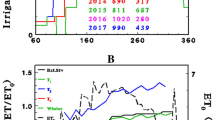Abstract
Water shortage is becoming a severe problem in arid and semi-arid regions worldwide, reducing the availability of agricultural land and water resources. Deficit irrigation strategies can improve water-use efficiency and the sustainability of agro-ecosystems, although it is important to model the effects on yield loss due to irrigation water restrictions. This work estimates the water production function in citrus trees, determining the relationship between plant water stress and yield depression, as well as establishing a mathematical model for each phenological stage considered (flowering, fruit growth and ripening), and for the entire productive process. For three consecutive years (2006–2008), four regulated deficit irrigation treatments plus a control (100% crop water evapotranspiration (ETC)) were implemented in 13-year-old citrus trees (Citrus sinensis L. Osb. cv. Navelina). Different water production functions were determined for each phenological stage, establishing the relationship between the irrigation water stress and crop yield. Our results show that the fruit growth and flowering stages were the most sensitive periods in relation to irrigation water deficit and yield loss. Water stress close to 50% of ETC during the flowering stage would impose a yield loss of up to 20%, whereas this same water stress level during the fruit growth or ripening stages would result in yield losses of nearly 10% and 6%, respectively. The adjustment with cross terms (r 2 = 0.87) estimated the yield loss with good accuracy, being very similar to data measured in each study season. Consequently, the combined effect of deficit irrigation in different stages would be an additive–multiplicative model, considering that the effect of water stress in previous periods determined the crop yield response. Our model indicated that the crop water production function under deficit irrigation programmes would have a quasi-linear relation for water deficits below to 40% ETC. The previous model functions did not enable us to establish an accurate relationship when the water stress was applied in different phenological stages. Thus, this new interpretation is valuable to improve our knowledge and predict the impact of regulated deficit irrigation and have potential application in precision water stress and sustainable irrigation scheduling for citrus.



Similar content being viewed by others
References
Azaiez MN (2008) Modeling optimal allocation of deficit irrigation: application to crop production in Saudi Arabia. J Math Model Algor 7:277–289. doi:10.1016/S0377-2217(00)00212-5
Azaiez MN, Hariga M (2001) A single period model for conjunctive use of ground and surface water under severe overdrafts and water deficit. Eur J Oper Res 133:653–666
Byung-Gook L, Yunbeom P (1998) Approximate conversion of rational Bézier curves. J KSIAM 2:88–93
Castel JR (1991) El riego de los cítricos. Hortifruticultura 5:41–52
Chalmers DJ, Burge G, Jerie PH, Mitchell PD (1986) The mechanism of regulation of Bartlett pear fruit and vegetative growth by irrigation withholding and regulated deficit irrigation. J Am Soc Hort Sci 111:904–907
Doorenbos J, Kassam AH (1979) Yield response to water. FAO Irrigation and Drainage paper no. 33.
Doorenbos J, Pruitt WO (1977) Las necesidades de agua de los cultivos. Estudio FAO. Riegos y Drenaje 24. FAO, Rome
FAO (1998) World reference base for soil resources. Food and Agriculture Organization of the United Nations, Rome
Fletcher R, Powell MJD (1963) A rapidly convergent descent method for minimization. Comp J 6:163–168
García-Tejero I, Jiménez JA, Reyes MC, Carmona A, Pérez R, Muriel JL (2008) Aplicación de caudales limitados de agua en plantaciones de cítricos del valle del Guadalquivir. Frutic Prof 173:5–17
García-Tejero I, Durán ZVH, Muriel JL, Rodríguez PCR (2011a) Water and sustainable agriculture. In: Springer Briefs in Agriculture. doi: 10.1007/978-94-007-2091-6
García-Tejero I, Durán ZVH, Muriel JL, Martínez GG, Jiménez BJA (2011b) Benefits of low-frequency irrigation in citrus orchards. Agron Sustain Dev 31:779–791. doi:10.1007/s13593-011-0025-1
Gill PE, Murray W, Wright MH (1981) Practical optimization. Academic, London
Goldhamer DA, Salinas M (2000) Evaluation of regulated deficit irrigation on mature orange trees grown under high evaporative demand. In: Albrigo LG (ed) Proceedings of the 9th Congress of the International Society of Citriculture. Global Citrus Germplasm Network, Orlando, pp 227–231
González-Altozano P, Castel JR (2000) Regulated deficit irrigation on ‘Clementina de Nules’ citrus trees. II. Vegetative growth. J Hort Sci Biotech 75:388–392
González-Altozano P, Castel JR (2003) Riego deficitario controlado en clementina de nules I. Efectos sobre la producción y la calidad de la fruta. Span J Agric Res 1:81–92
Hexem RW, Heady EO (1978) Water production functions for irrigated agriculture. Center for Agricultural and Rural Development, Iowa State University Press, Ames
Houndari M, Azaiez MN (2001) Optimal cropping patterns under water deficit. Eur J Oper Res 130:133–146. doi:10.1016/S0377-2217(00)00028-X
Jensen ME (1968) Water consumption by agricultural plants. In: Kozlowski TT (ed) Water deficit and plant growth, vol 2. Academic, New York, pp 1–22
Kipkorir EC, Raes D, Massawe B (2002) Seasonal water production functions and yield response factors for maize and onion in Perkerra, Kenya. Agric Water Manag 56:229–240. doi:10.1016/S0378-3774(02)00034-3
Martin DL, Watts DG, Gilley JR (1984) Model and production function for irrigation management. J Irrig Drain Eng 110:149–164. doi:10.1061/(ASCE)0733-9437(1984)110:2(149)
Moriasi DN, Arnold JG, Van Liew MW, Bingner RL, Harmel RD, Veith TL (2007) Model evaluation guidelines for systematic quantification of accuracy in watershed simulations. Trans ASABE St Joseph Mich 50:885–900
Nash JE, Sutcliffe JV (1970) River flow forecasting through conceptual models part I—a discussion of principles. J Hydrol 10:282–290. doi:10.1016/0022-1694(70)90255-6
Rao NH, Sarma PBS, Chander S (1988) A simple dated water-production function for use in irrigated agriculture. Agric Water Manag 13:25–32. doi:10.1016/0378-3774(88)90130-8
Severini S, Cortignani R (2008) Introducing deficit irrigation crop techniques derived by crop growth models into a positive mathematical programming model. 12th Congress of the European Association of Agricultural Economist. EAAE, The Hague
Stewart JI, Hagan EM (1973) Functions to predict effects of crop water deficits. J Irrig Drain Div ASCE 99:421–439
Stewart JI, Cuenca RH, Pruitt WO, Hagan RM, Tosso J (1977) Determination and utilization of water production functions for principal California crops. W-67 CA. Contributing Project Report. University of California, Davis
Acknowledgements
The authors acknowledge the support of research project RTA2008-00058-CO3-03 co-financed with FEDER funds (European Union). I. Garcia-Tejero received a research fellowship from INIA (PRE-2007). The authors also thank J. García-Baquero and M.A. Fernández-Ayala for the field data collection and laboratory analyses.
Author information
Authors and Affiliations
Corresponding author
About this article
Cite this article
García-Tejero, I., Durán-Zuazo, V.H., Arriaga-Sevilla, J. et al. Impact of water stress on citrus yield. Agron. Sustain. Dev. 32, 651–659 (2012). https://doi.org/10.1007/s13593-011-0060-y
Accepted:
Published:
Issue Date:
DOI: https://doi.org/10.1007/s13593-011-0060-y




